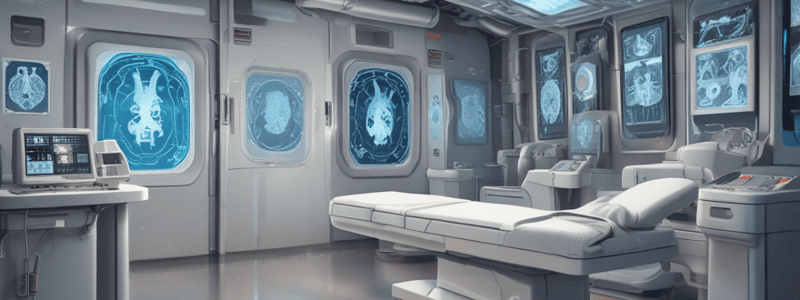Podcast
Questions and Answers
What is the primary difference between the third-generation CT scanners and their predecessors?
What is the primary difference between the third-generation CT scanners and their predecessors?
- The incorporation of a curved detector array (correct)
- The use of translation motion
- The use of only 100 detectors
- The use of a fan beam of x-rays
What is the chief advantage of third-generation CT scanners?
What is the chief advantage of third-generation CT scanners?
- They are more expensive
- They use a smaller detector array
- They can acquire projection data for a single image in as little as 1 s (correct)
- They are slower than second-generation systems
How many detectors are typically found in a third-generation CT scanner?
How many detectors are typically found in a third-generation CT scanner?
- 1000-2000
- 200-500
- 500-1000 (correct)
- 100-200
What is the range of motion of the fan beam of x-rays in a third-generation CT scanner?
What is the range of motion of the fan beam of x-rays in a third-generation CT scanner?
What is the primary purpose of the fan beam of x-rays being wide enough to completely contain the patient?
What is the primary purpose of the fan beam of x-rays being wide enough to completely contain the patient?
Flashcards are hidden until you start studying
Study Notes
Third Generation CT Scanners
- A fan beam of x-rays is rotated 360 degrees around the isocenter in third-generation CT scanners.
- No translation motion is used in this generation of CT scanners.
- The fan beam must be wide enough to completely contain the patient.
- A curved detector array consisting of several hundred independent detectors (500-1000) is mechanically coupled to the x-ray source.
- The x-ray source and detector array rotate together to acquire projection data for a single image.
- The rotation-only motion of third-generation scanners enables the acquisition of projection data in as little as 1 second.
- Third-generation systems are typically faster than second-generation systems.
- The detectors in this generation have incorporated a larger amount of sensors in the detector array.
Studying That Suits You
Use AI to generate personalized quizzes and flashcards to suit your learning preferences.




